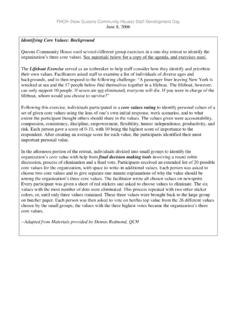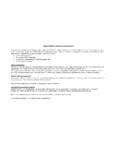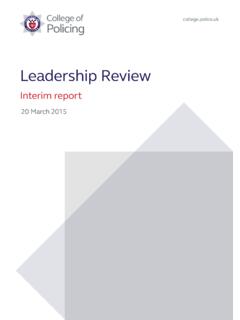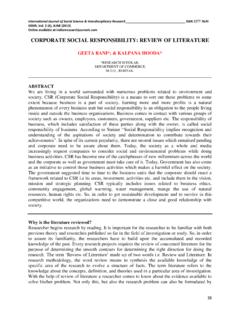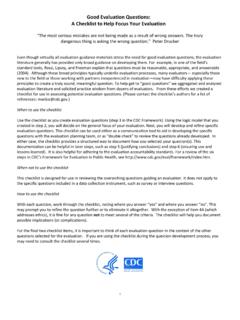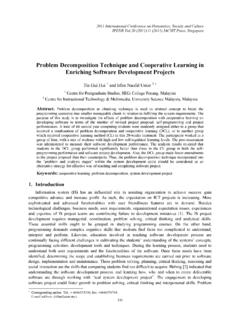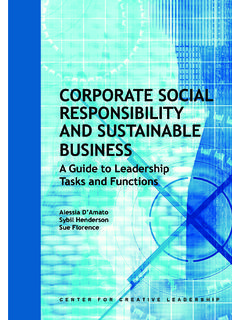Transcription of Nonprofit Governance Models: Problems and Prospects
1 Nonprofit Governance Models: Problems and Prospects1. Pat Bradshaw, York University Bryan Hayday, Innovaction Ruth Armstrong, Vision Management Services Johanne Levesque, Canadian Health Network Liz Rykert, Meta Strategies Paper Originally presented at the ARNOVA Conference Seattle Washington, 1998. 1. Please address questions about this paper to Dr. Pat Bradshaw, Schulich School of Business, York University, 4700 Keele Street, Toronto, Ontario, Canada, M3J 1P3. Nonprofit Governance Models: Problems and Prospects Abstract Drawing on our experiences in developing a new Governance model for the Canadian Health Network, in this paper we argue that there is currently no agreement about a prescriptive or ideal model of Nonprofit Governance .
2 Rather we suggest within the current diversity of thought about Governance there is an exciting opportunity to create new models which are hybrids of existing and emerging models with the selection of the best model based on a contingency approach. The paper begins with a review and critique of the normative and academic literatures on Nonprofit boards looking at the assumptions which inform each. The paper then characterizes existing Governance models along two dimensions: established vs. innovative and unitary vs. pluralistic. This provides us with a way of mapping current perspectives according to four different models; the Policy Governance model , the Entrepreneurial model , the Constituency model and the Emergent Cellular model .
3 The paper briefly describes the characteristics of each model and outlines the positive and negative features of each. The paper concludes by describing a new hybrid model which embraces the strengths of each model and also capitalizes on some of the new ways of framing management in turbulent times. Nonprofit Governance Models: Problems and Prospects2. INTRODUCTION. This paper has grown out of work done by the authors in framing a model of Governance for the Canadian Health Network (CHN), a newly created, multi-stakeholder, network organization which is embracing new models of management. We believe that existing models of non-profit Governance are not appropriate for such an organization given its context, goals and values.
4 The purpose of this paper is to share the conceptual thinking that went into the process of re-framing Governance and the hybrid model of Governance which we generated. It is hoped that this work will help liberate more innovation and creativity in the field of non-profit Governance . The paper starts by outlining the assumptions underlying the work, and then moves to a literature review and a description of the framework that was developed to characterize the field of Governance and ends with some ideas about how a new, hybrid model has been operationalized. ASSUMPTIONS UNDERLYING THE PAPER. This paper is underpinned by some fundamental assumptions which need to be addressed up-front.
5 First, we believe that there is no ideal way of conceptualizing Governance and as Abzug concludes there is no one best way to structure and compose a board of directors (Abzug, 1996). Also, as Dornstein (1988) suggested, we assume a contingency approach for selecting board structure and composition is most appropriate and needs to be based on the particular circumstances of each individual enterprise. As Brudney and Murray (1998) suggest the board model that is best for one organization is not necessarily best for another and decisions about Governance need to be based on the configuration of personalities, culture and environmental 2. We want to acknowledge the financial support of Health Canada for this project and the administrative help of Susan Himel, Sandy Barkin and Naida Harris-Morgan.
6 The Canadian Health Network can be found at pressures unique to each Nonprofit organization. In essence, we agree with Maranville's (1999). call for requisite variety. Based the search for the best fit with environment and with input from a consultation group, we set out to conceptualize a model of Governance which is the most appropriate for the Canadian Health Network (CHN) and its Advisory Board of Directors. The CHN is a newly created organization in a turbulent and political environment. The organization is created and funded in a contractual relationship (Coston, 1998) by Health Canada in order to provide reliable, easily accessed and internet based health information to Canadians.
7 CHN is structured as a network of networks and has been initiated as a partnership between the Federal government and a large number of affiliate and associate Nonprofit organizations (currently over 500. affiliated members). It is administered by a secretariat which works under contract to provide logistical and technical support for this distributed network of partner organizations. The structure of this organization is organic, networked and emergent and the technology is also networked, distributed and highly flexible. The technology enables new organizational forms because it overcomes limitations of time and place associated with traditional technologies. The organization is operating in a context of multiple stakeholders with diverse beliefs and styles of operation.
8 Power is somewhat distributed but the goal is to be interdependent and balanced in sharing power (what Coston, 1998 describes as mutual dependence) based on a world view which values adaptability, innovation, partnership and emergence. We assumed in the development stages of this project that existing Governance models, which appear to work well in more stable environments and in organizations which are hierarchical, stable and centralized with few known stakeholders and a routine technology would not be the best in this different context. (See Table 1 which shows a type of contingency framework and in which CHN falls closer to the right side). We also assumed that we needed to conceptualize a new Governance model that is more organic, flexible and open to shared power.
9 As stated above the other premise underlying this work is based on our assessment of the literature on Nonprofit Governance . We see this literature as diverse and as containing no strong 4. consensus about a single or ideal model of Governance . In the following section we will review the relevant literatures in order to explore this diversity and set the stage for the framework of alternative models we conceptualize. LITERATURE REVIEW. Governance has only relatively recently become a focus of concern in organizational theory and management. Until about fifteen years ago there was an implicit assumption that the board room was a context which was not open for exploration and the role, function and structure of boards was not widely examined.
10 With the growing awareness of the importance of Governance have come a number of critical debates and normative suggestions about the "ideal" board. While some consultants and theorists suggest that there is one best formula or approach for creating effective boards, in the following literature review we will show how little agreement there is about what constitutes effective Governance . While it appeared for some time that the field was moving towards a type of consensus about a single and "best" model of Governance , we are now seeing more divergence of thinking and an active process of articulating alternative Governance models. This creative process is partially the result of the emergence of new approaches to management in general.

